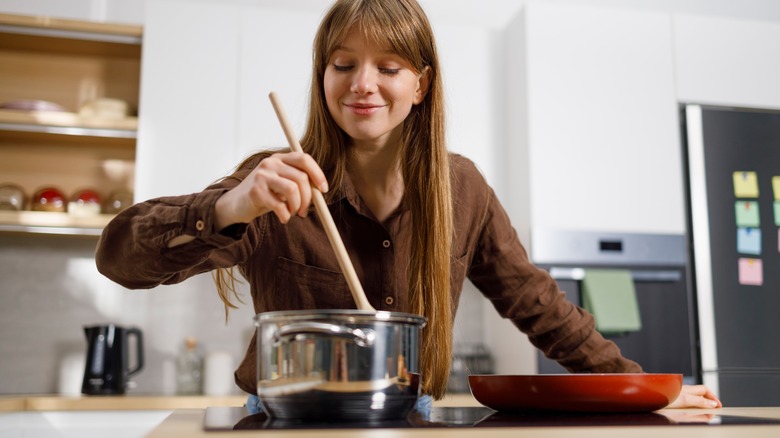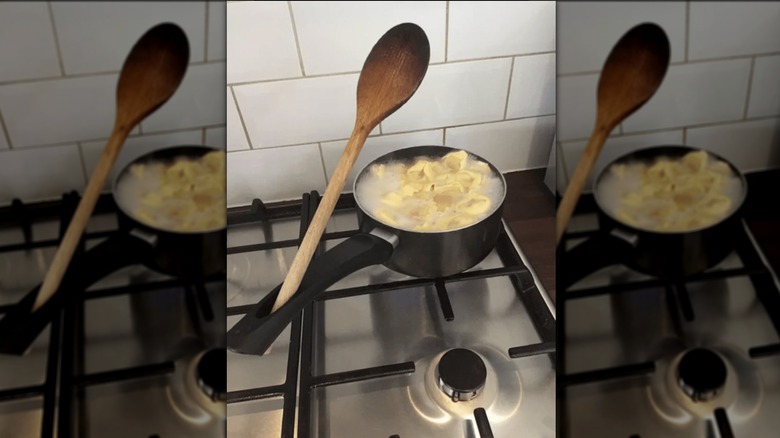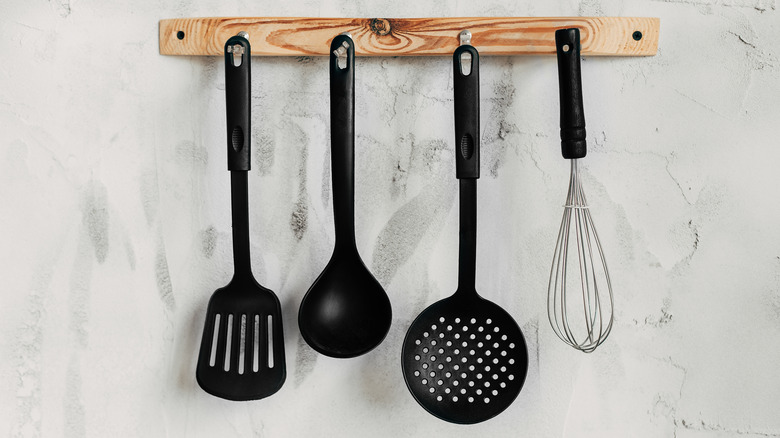The Hole In Your Pot Handle Was Made To Hold Messy Stirring Spoons
Picture this: you're stirring a pot of sauce or soup on the stove but aren't sure where to put your spoon in between stirs. You shouldn't leave it in the pot, as some spoons like nylon cooking tools can melt at high temperatures or burn. You could set it on a plate or in a bowl, but you'll be left with yet another dish to wash. You could use a paper towel, but the warm liquids left on the spoon might end up soaking through, leaving behind a mess on the counter. If you don't have a designated (and perhaps stylish) spoon rest, there is one simple hack you can try: using the pot or pan's handle.
Many pieces of stovetop cookware have holes at the end of their handles. This feature is most commonly used to hang up pots and pans for convenient, out-of-the-way storage, but it also doubles as a holder for a stirring spoon. While this won't work for all sizes and shapes of cookware and cooking utensils, it can be an easy way to free up precious counter space and save you from extra cleaning.
Make the most of this built-in spoon rest
If you're cooking with a pot or pan that has a hole in its handle, using it to hold your cooking tool is fairly straightforward. Try placing the clean end of your spoon or spatula in the hole at an angle that won't cause it to slide right through. This should leave the messy side of your cooking tool positioned directly over your cookware, keeping your kitchen tidy. Be mindful of how you position the spoon as you don't want sauce or other liquid to drip down the handle instead of back into the pot or pan.
This built-in spoon rest hack works particularly well with wooden cooking tools in particular. Since they don't conduct heat and are made from natural, hygienic materials, you won't have to worry about your wooden stirring spoons getting too hot and burning you or melting into your food. Silicone tools may also be safe to rest in this position, but note that they usually have a maximum temperature rating of 400–500 degrees Fahrenheit.
You'll probably discover that this trick won't work for all shapes and sizes of cooking utensils. That's why it's a good idea to test it out at home to determine which combinations of cookware and tools work best.
Be careful with certain cooking tools
While using the hole at the end of your pot or pan as a spoon rest is convenient, there are some types of utensils you shouldn't do this with. Avoid leaving metal cooking tools propped up like this, as their proximity to a hot handle and stovetop could cause the metal to heat up. This may put you at risk of burning your hand the next time you go to stir your food. Cookware and tools with rubberized handles are less heat-conductive, but you should still be careful if you prop them up this way.
Plastic utensils should also always be kept away from heat when not in use. When used at high temperatures (or worse, when left in a hot pan), cooking tools made from plastic can leach toxic chemicals into your food. In some cases, they can even melt, leaving you with a ruined meal and damaged cookware.
By figuring out which of your cooking utensils you can use for this built-in spoon rest hack, you'll be on your way to a more convenient cooking experience. Pretty soon, you'll be able to spend less time and energy washing extra dishes or scrubbing your counters and stovetop clean.


